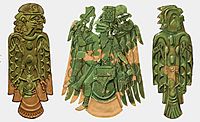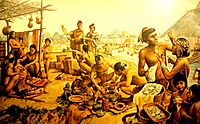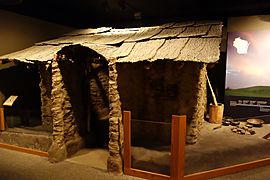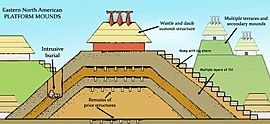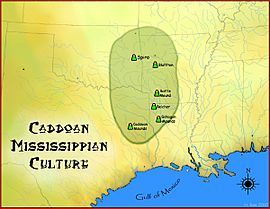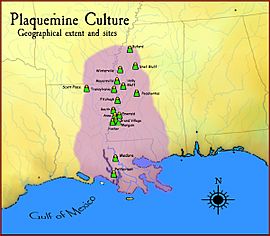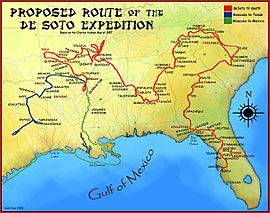Mississippian culture facts for kids
The Mississippian culture was a way of life for Native Americans who lived in the Mississippi River Valley. This culture grew and spread across the Eastern United States from about 900 to 1450 AD. Mississippian people were mostly farmers. They settled in river valleys and grew important crops like corn, beans, and squash, often called the "three sisters."
These people lived across a large area. This stretched from the Florida panhandle west to Oklahoma. It went north to Minnesota and east to Ohio.
Contents
What Made Them Special?
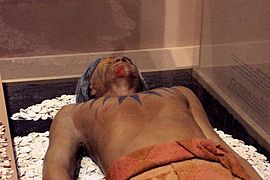

The Mississippian people had several unique ways of life. Not all groups did everything listed below. But these traits made them different from earlier groups.
- Building Mounds: They built large, flat-topped earthwork mounds. These were usually square, rectangular, or sometimes round. They built houses, temples, or burial buildings on top of these mounds.
- Farming Corn: Growing lots of corn was very important. This allowed more people to live together. It also let some people focus on special crafts.
- Shell Pottery: They made pottery using crushed shells mixed into the clay. This made their pots stronger.
- Wide Trade: They traded goods over long distances. Their trade networks reached from the Rocky Mountains to the Atlantic Ocean. They also traded from the Great Lakes to the Gulf of Mexico.
- Chiefdoms: Their societies were organized into "chiefdoms." This meant a few powerful leaders, or one main chief, were in charge.
- Social Classes: People were not all equal in their society. Some families had more power and importance than others.
- Centralized Power: A few people, or one person, held both political and religious power.
- Town Networks: They had a system of towns. One large center, with many mounds, controlled smaller towns around it. These smaller towns might have had fewer mounds.
- Shared Beliefs: They had a shared belief system called the Southeastern Ceremonial Complex (SECC). This system included special art and symbols. These items are found in Mississippian sites across a huge area. This belief system was often connected to games, like "chunkey."
The Mississippians did not have a writing system. They also did not build with stone. They worked with natural metals like copper. They hammered copper into ritual objects and decorations. But they did not melt iron or make bronze.
Time Periods
The Mississippian culture developed over different time periods. These periods varied from place to place. A site might start a new period earlier or later than another.
- Early Mississippi Period (about 1000–1200 CE): During this time, groups changed from a simpler way of life. They started living in one place more. They also began farming more and building bigger towns. Growing extra corn helped populations grow quickly in major centers.
- Middle Mississippi Period (about 1200–1400 CE): This was the peak of the Mississippian culture. The huge city of Cahokia grew very large. Other complex chiefdoms formed. The special art and symbols of the SECC spread widely. Many of the Mississippian traits became common everywhere.
- Late Mississippi Period (about 1400–1540 CE): This period saw more fighting and people moving around. The population of Cahokia scattered around 1350–1400 CE. People built more defenses at their sites. Mound-building and large public ceremonies sometimes decreased. By 1500 CE, many areas had fewer people or faced big social problems. This happened around the same time as a global climate change called the Little Ice Age. Experts think droughts and less corn farming, along with cutting down too many trees and overhunting, made people move away from big sites. This period ended when Europeans arrived in the 1500s.
Different Regions
Middle Mississippian
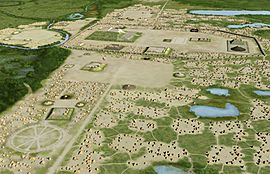
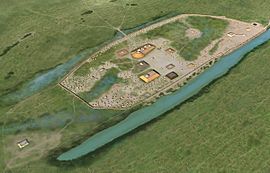
The "Middle Mississippian" area was the heart of the classic Mississippian culture. It covered the central Mississippi River Valley and the lower Ohio River Valley. It also included parts of Kentucky, Tennessee, Alabama, and Mississippi. Sites here often had large ceremonial mounds and living areas. They were often surrounded by ditches or wooden fences called palisades.
Middle Mississippian cultures, especially the powerful group at Cahokia (near East St. Louis, Illinois), greatly influenced other societies. Special items like stone statues and fancy pottery from Cahokia have been found far away. Local artists also copied these items.
- Cahokia: This was the largest and most complex Mississippian site. It was the biggest settlement north of Mexico before Europeans arrived. Cahokia was the most important Mississippian center. Discoveries there include copper workshops and special burials.
- Angel Mounds: A chiefdom in southern Indiana. Some experts believe the later Caborn-Welborn culture grew from the Angel Phase people.
- Kincaid Site: A major Mississippian mound center in southern Illinois. It is across the Ohio River from Paducah, Kentucky.
- Moundville: This site is near Tuscaloosa, Alabama. It is considered one of the two most important Mississippian sites, along with Cahokia.
- The Parkin Site: This site is important for understanding the Late Mississippian culture. Many experts believe it was the home of the Casqui people. Hernando de Soto visited them in 1542.
South Appalachian Mississippian
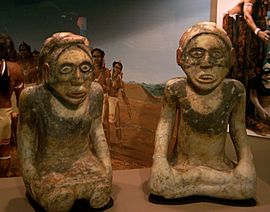
This area includes Alabama, Georgia, northern Florida, South Carolina, North Carolina, and Tennessee. Mississippian culture influenced this region later than the Middle Mississippian area. It is thought that people here learned Mississippian ways from their neighbors to the northwest.
Typical settlements were on river floodplains. They included villages with defensive fences. These fences enclosed mounds and living areas. Etowah, Ocmulgee, and Moundville are good examples of these settlements.
Caddoan Mississippian
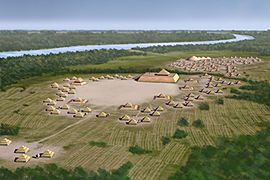
The Caddoan Mississippian area was very large. It covered parts of Oklahoma, Arkansas, Texas, and Louisiana. Experts agree that the Caddo people living today are direct descendants of these ancient groups.
The climate here was drier, which made growing corn harder. Major sites like Spiro were in fertile river valleys. These areas were best for corn farming. These sites usually did not have wooden fences like towns in the Middle Mississippian area. Living on the western edge of the Mississippian world, the Caddoans may have faced fewer military threats.
The Caddoan people spoke one of the many Caddoan languages. Today, only a few elderly people still speak Caddo and Pawnee.
Hernando de Soto explored this area in the early 1540s. He met several native groups who are now thought to be Caddoan. The Caddo were organized into three main groups. These groups were connected by their similar languages.
Plaquemine Mississippian
The Plaquemine culture was in the lower Mississippi River Valley. This included western Mississippi and eastern Louisiana. Important sites include Medora, Anna, Emerald Mound, Winterville, and Holly Bluff. This culture existed at the same time as the Middle Mississippian culture at Cahokia. It is believed to be the ancestor of the Natchez and Taensa Peoples.
- Emerald Mound: This site is near Stanton, Mississippi. It dates from 1200 to 1730. Its platform mound is the second-largest ancient earthwork in the country. Only Monks Mound at Cahokia is larger.
- Grand Village of the Natchez: This was the main village of the Natchez people. It had three mounds. It is the only mound site that was still used and cared for when Europeans arrived.
Modern Connections
Mississippian peoples are almost certainly the ancestors of most Native American nations living in this region today. These include the Alabama, Apalachee, Caddo, Chickasaw, Catawba, Choctaw, Muscogee Creek, Guale, Hitchiti, Houma, Kansa, Missouria, Mobilian, Natchez, Osage, Quapaw, Seminole, Tunica-Biloxi, Yamasee, and Yuchi.
Meeting Europeans
Experts have studied records from Hernando de Soto's journey from 1539–1543. These records tell us about his meetings with Mississippian people. He traveled through their villages in the Southeast. He stayed in some villages for a month or more. Some meetings were violent, while others were peaceful. Sometimes, de Soto seemed to be used by native groups in their own long-standing conflicts. For example, de Soto helped make peace between the Pacaha and the Casqui.
De Soto's later encounters led to many deaths. About half of his Spanish soldiers died. Hundreds of Native Americans also died. De Soto's writings are some of the first documents about Mississippian peoples. They give us valuable information about their culture.
After de Soto's group left, the Mississippian people continued their way of life. But European contact changed things greatly. Native people had no immunity to new diseases like measles and smallpox. These diseases caused many deaths. This weakened the social order of many chiefdoms. Some groups started using European horses and became nomadic. Their political systems collapsed in many places.
At Joara, near Morganton, North Carolina, Mississippian people met Spanish explorers. The Juan Pardo expedition built a fort there in 1567 called Fort San Juan. Records and archaeological finds show what happened. The soldiers stayed at the fort for about 18 months. Then, the natives killed them and destroyed the fort. They also killed soldiers at five other forts. Only one man out of 120 survived. Spanish items from the 1500s have been found at the site. This marks the first European settlement in the interior of what is now the United States.
By the time more written accounts were made, the Mississippian way of life had changed forever. Some groups, like the Cherokee in the late 1800s, still remembered their mound-building past through stories. But other Native American groups had moved far away. They had lost their elders to diseases. They did not know their ancestors had built the mounds across the land. This led to a false idea that the Mound Builders were a different people from Native Americans. This idea was proven wrong by Cyrus Thomas in 1894.
See also
 In Spanish: Cultura misisipiana para niños
In Spanish: Cultura misisipiana para niños


